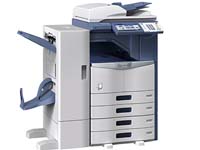Multifunction photocopiers an essential tool for schools

 Scientific breakthroughs in even the earliest models.
Scientific breakthroughs in even the earliest models.
In the earlier years of the desk-top computer age, there were confident predictions that the average office would soon be paperless. Those predictions have proved to be far from the mark with many offices and schools handling more paper than ever.
Those early predictions almost certainly did not take account of the rapid transformation of the photocopier. Earlier versions were extremely limited in what they could do and tended to jam frequently. Printing had to be done separately.
However, even these far simpler machines were still really a modern scientific miracle. In 2013, few will remember just the sort of situations photocopiers have freed us from since the first appeared in any numbers in the 1970s Imagine having to resort to making carbon copies of important documents, as many people did before copiers came along? Or worse, imagine how tedious it would be if everything had to be recopied by hand!
We should be incredibly grateful for modern technology. At its heart, a copier works because of one basic physical principle: opposite charges attract. Static electricity is the copier’s secret.
Inside a copier there is a special drum. The drum acts a lot like a balloon – it can be charged with a form of static electricity.
Inside the copier there is also a very fine black powder known as toner. The drum, charged with static electricity, can attract the toner particles.
There are three things about the drum and the toner that let a copier perform its magic:
• The drum can be selectively charged, so that only parts of it attract toner. In a copier, you make an “image” — in static electricity — on the surface of the drum. Where the original sheet of paper is black, you create static electricity on the drum. Where it is white you do not. What you want is for the white areas of the original sheet of paper to NOT attract toner. The way this selectivity is accomplished in a copier is with light — this is why it’s called a photocopier!
• Somehow the toner has to get onto the drum and then onto a sheet of paper. The drum selectively attracts toner. Then the sheet of paper gets charged with static electricity and it pulls the toner off the drum.
• The toner is heat sensitive, so the loose toner particles are attached (fused) to the paper with heat as soon as they come off the drum. The drum, or belt, is made out of photoconductive material.
This is only a small part of the technology involved. The complexity of the lighting and lenses involved would be baffling to all but advanced experts in their fields. However, this very short introduction might be enough to demonstrate that even earliest versions involved highly sophisticated science in freeing us from the drudgery of the carbon paper age. Who would want to return to those times?
The age of the Multi-Function-Device
However, photocopiers have come a long way since those early models that many would remember. From being a simple tool for making copies of worksheets and other school documents, today’s photocopiers have been merged with printers and now allow users to not only copy, but also print, scan and fax documents.
Known as multifunction photocopiers (MFDs) the latest models, such as Toshiba’s e-STUDIO 2550/3540/6550 models can also access the internet, be a portal for using software applications, and wirelessly interact with smart phones, laptops and tablets.
There are many benefits to using a multifunction photocopier in place of a range of standalone devices. In particular the cost savings can be quite significant.
The technology involved in MFDs has evolved to the point where the cost per page is much lower than that of stand-alone desktop printers, says Jim Nolan, regional manager for Toshiba in New Zealand.
“And of course, MFDs offer functions of greater quality – whether that be print (via colour control tools); distribution (via scanning to email/network/internet/USB or hard drive); or document output finishing (via punching, stapling, folding and booklet making).”
As well as being cheaper to run overall, MFDs also utilise reporting technology that means schools can track costs and monitor departmental or individual usage.
“With Toshiba technology you can set limits for certain staff or students, and you can set rules that recommend another print device be used. These print rules are chosen by the school, based on things like cost-effectiveness, peak-usage trends, or security,” said Mr Nolan. “A recent trend emerging is card access for MFDs, which can be extended to other ‘purchases’ around the school – parents can view all transactions and add value online if the school is on-charging.
“With our proactive service support model we will often know about a potential issue and deal with it before a school is aware of it – since our back-end service system receives information directly from our MFDs. Our goal is to keep our schools operating happily at all times with our MFDs and software. And we are now introducing an even more advanced system whereby our Help Desk can (with the school’s permission) log-in to the management hub and help with any MFD issues,” he said.









